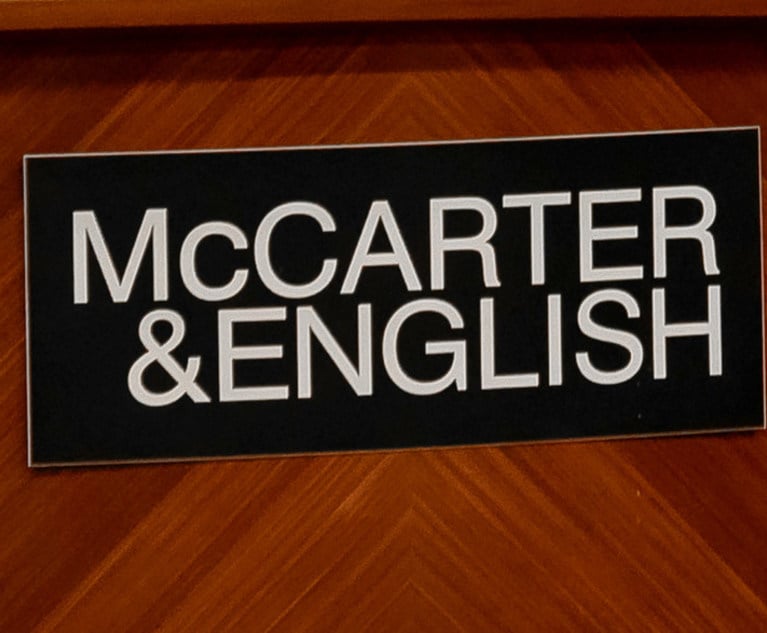Why Does the Gender Wage Gap Persist in Law?
The reports of the old boy network's death are greatly exaggerated.
April 03, 2018 at 09:39 AM
7 minute read
The original version of this story was published on Law.com
 Women have been fighting for equal rights since the early days of the Republic. In 1776, Abigail Adams petitioned her husband John, admonishing him not to put unlimited power into the hands of men. John Adams replied, “I cannot but laugh. Depend upon it, we know better than to repeal our masculine systems.” Fast forward to 2018: Adams and his fellow founders would be relieved to know those “masculine systems” are very much alive in the legal industry. The parochial, homogeneous, male-dominated, legal guild is showing signs of fraying, but the evidence shows it is still very much alive. The reports of the old boy network's death are greatly exaggerated.
Women have been fighting for equal rights since the early days of the Republic. In 1776, Abigail Adams petitioned her husband John, admonishing him not to put unlimited power into the hands of men. John Adams replied, “I cannot but laugh. Depend upon it, we know better than to repeal our masculine systems.” Fast forward to 2018: Adams and his fellow founders would be relieved to know those “masculine systems” are very much alive in the legal industry. The parochial, homogeneous, male-dominated, legal guild is showing signs of fraying, but the evidence shows it is still very much alive. The reports of the old boy network's death are greatly exaggerated.
Elimination of Legal Industry Bias is a Goal, Not a Reality
The elimination of bias in the legal profession is one of the stated goals of the American Bar Association. Law has long had a bias problem—gender, race, religion, and lifestyle preference, among others. There are two principal reasons: (1) broader societal bias; and (2) legal culture. Lawyers commit to defend individual and societal rights. They are the first responders and last defenders of the rule of law. And they are self-regulated. So how and why is the profession anything but a model of equality?
Legal culture was forged by middle-aged white men of like mind, means, and background. It was designed to serve their interests financially, socially, and inter-generationally. Approximately half of newly minted lawyers are female, but don't mistake numerical parity with equality in pay, promotion, or influence.
A Quick Review of the Numbers
Any way you slice them, the numbers, as lawyers say, establish a prima facie case of gender discrimination. The ranks of female managing partners are growing slowly and grab headlines. This creates a false positive reading of how female lawyers are faring overall. Consider that among the AmLaw 200, women comprise only 4 percent of executive management overall; 19 percent of all equity partners; 23 percent of top governing committees; and 28 percent of promotion and compensation committees. And according to 2014 data released by the U.S. Census Bureau, full-time female lawyers earn 77 percent of what male lawyers do.

There's even more bad news for women. The data reveals that the higher the compensation level, the more pay increase is increasingly skewed in favor of men. One hundred percent of firms reported that its highest paid partner is male. How can male attorneys represent women—or other minorities– in wage discrimination cases? And what about the Equal Pay Act of 1963 that prohibits sex-based wage discrimination?

The situation is no better for female attorneys in the UK, the second largest legal market behind the U.S. Under the Equality Act 2010, companies in the United Kingdom with more than 250 employees must submit data to the government each year on their gender pay gaps. Linklaters, a Magic Circle firm, released its 2017 figures revealing that men at the firm, on average, received about 58% more in bonus money and 23% more in hourly pay than women. The bonus and pay gaps of the other Magic Circle firms are roughly consistent. The “old boy club” persists on both sides of the pond.
One might think women would fare better in corporate legal departments where origination—often a subjective determination—is the sine qua non for compensation, advancement, and management influence. Corporate lawyers are rewarded for being good managers of internal and outsourced matters; mitigating risk; achieving quantifiable results; and partnering with clients to advance enterprise objectives. But even in an environment devoid of origination and the expectation of massive billed hours, a significant gender pay disparity exists among corporate legal departments.
The 2017 In-House Counsel Compensation Report of legal recruiting firm Major, Lindsey & Africa reveals that female attorneys working in-house are paid significantly less than their male colleagues at all levels. While women are more likely to occupy the big chair in-house than at firms–25% of General Counsel positions at Fortune 500 companies (and 22.5% among the Fortune 1000)—they are not paid the same as their male counterparts. Total 2016 compensation for men was 17.5% higher than for women. Base salaries of male GC's were 6.3 percent higher and bonuses 31% higher than female GC's. The highest male bonus was $3 million, compared to the top female bonus of $675,000. A new report from the Association of Corporate Counsel draws “a dramatic picture of gender pay disparity” for women in-house lawyers.
What Will Move the Needle?
There is a legion of explanations for the why of gender wage disrimination–too many men in senior management, too many male legal buyers, male control of the sell side, work/life balance (not exclusive to women but a male tool to discriminate), workplace and sexual politics, gender stereotyping and males turning a blind eye to the problem. These are all characteristics of a legal culture that is tradition-bound, labor-intensive, elitist—as to pedigree, licensure, and, gender– and cautious.
But what will change legal culture and eliminate gender pay inequality? The legal profession (attorneys) is becoming subsumed by the business of delivering legal services. That means, among other things, that the myth of lawyer exceptionalism is over, and attorneys no longer decide what is a “legal” matter and when lawyers are required. Lawyers routinely collaborate with other professionals, paraprofessionals, and machines. The industry is attracting investors, entrepreneurs, and globalists that see an opportunity to scale the delivery of the business of law. Law is not exclusively about lawyers anymore. The infusion of new skillsets, delivery models, and the replacement of the old guard by the next generations will help to change legal culture. But this will take time.
Legal buyers can drive fundamental changes and accelerate law's transition from its incumbent culture. The gender wage gap will persist until legal buyers get serious about remediating it. Some large companies are already requiring vendors—including legal providers—to demonstrate diversity as a condition of doing business with them. That's a start, but it's not a cure for the problem.
Diversity and parity is not a box-checking exercise; it is a cultural commitment to a common set of core values. It is a statement of and commitment to what the organization stands for. Equal pay, opportunity for advancement, mentorship, retention, work/life balance, flexible working conditions (law is a knowledge business that seldom requires people to engage from a specific location or at a designated hour), and zero-tolerance for discrimination of any kind is what the legal industry must aspire to and legal buyers should demand. It begins with the hiring process; is reinforced from the top-down; and must permeate the organization.
Conclusion
A proliferation of recent wage discrimination and sexual harassment suits is casting a light on the dark side of legal culture. Employee handbooks, diversity statistics, and innovation awards are often window dressing that masks an ugly legal culture disguised by an elegant patina.
The legal industry must take a hard look at its culture and understand that technology, process, new delivery models, and other indices of innovation are footnotes to core values. If the legal industry does not commit to end the scourge of its internal discrimination, how can it have standing to do so for others?
Mark A. Cohen is the Chairman, Board of Advisors & Chief Strategy Officer at Elevate and a Distinguished Fellow at Northwestern University Pritzker School of Law
This content has been archived. It is available through our partners, LexisNexis® and Bloomberg Law.
To view this content, please continue to their sites.
Not a Lexis Subscriber?
Subscribe Now
Not a Bloomberg Law Subscriber?
Subscribe Now
NOT FOR REPRINT
© 2025 ALM Global, LLC, All Rights Reserved. Request academic re-use from www.copyright.com. All other uses, submit a request to [email protected]. For more information visit Asset & Logo Licensing.
You Might Like
View All
How a Paul Weiss Associate’s Career Took Off With Help From a Social Mobility Alliance
6 minute read

Former McCarter & English Associate Fired Over 'Gangsta Rap' LinkedIn Post Sues Over Discrimination, Retaliation
6 minute read
T14 Sees Black, Hispanic Law Student Representation Decline Following End of Affirmative Action
Trending Stories
Who Got The Work
J. Brugh Lower of Gibbons has entered an appearance for industrial equipment supplier Devco Corporation in a pending trademark infringement lawsuit. The suit, accusing the defendant of selling knock-off Graco products, was filed Dec. 18 in New Jersey District Court by Rivkin Radler on behalf of Graco Inc. and Graco Minnesota. The case, assigned to U.S. District Judge Zahid N. Quraishi, is 3:24-cv-11294, Graco Inc. et al v. Devco Corporation.
Who Got The Work
Rebecca Maller-Stein and Kent A. Yalowitz of Arnold & Porter Kaye Scholer have entered their appearances for Hanaco Venture Capital and its executives, Lior Prosor and David Frankel, in a pending securities lawsuit. The action, filed on Dec. 24 in New York Southern District Court by Zell, Aron & Co. on behalf of Goldeneye Advisors, accuses the defendants of negligently and fraudulently managing the plaintiff's $1 million investment. The case, assigned to U.S. District Judge Vernon S. Broderick, is 1:24-cv-09918, Goldeneye Advisors, LLC v. Hanaco Venture Capital, Ltd. et al.
Who Got The Work
Attorneys from A&O Shearman has stepped in as defense counsel for Toronto-Dominion Bank and other defendants in a pending securities class action. The suit, filed Dec. 11 in New York Southern District Court by Bleichmar Fonti & Auld, accuses the defendants of concealing the bank's 'pervasive' deficiencies in regards to its compliance with the Bank Secrecy Act and the quality of its anti-money laundering controls. The case, assigned to U.S. District Judge Arun Subramanian, is 1:24-cv-09445, Gonzalez v. The Toronto-Dominion Bank et al.
Who Got The Work
Crown Castle International, a Pennsylvania company providing shared communications infrastructure, has turned to Luke D. Wolf of Gordon Rees Scully Mansukhani to fend off a pending breach-of-contract lawsuit. The court action, filed Nov. 25 in Michigan Eastern District Court by Hooper Hathaway PC on behalf of The Town Residences LLC, accuses Crown Castle of failing to transfer approximately $30,000 in utility payments from T-Mobile in breach of a roof-top lease and assignment agreement. The case, assigned to U.S. District Judge Susan K. Declercq, is 2:24-cv-13131, The Town Residences LLC v. T-Mobile US, Inc. et al.
Who Got The Work
Wilfred P. Coronato and Daniel M. Schwartz of McCarter & English have stepped in as defense counsel to Electrolux Home Products Inc. in a pending product liability lawsuit. The court action, filed Nov. 26 in New York Eastern District Court by Poulos Lopiccolo PC and Nagel Rice LLP on behalf of David Stern, alleges that the defendant's refrigerators’ drawers and shelving repeatedly break and fall apart within months after purchase. The case, assigned to U.S. District Judge Joan M. Azrack, is 2:24-cv-08204, Stern v. Electrolux Home Products, Inc.
Featured Firms
Law Offices of Gary Martin Hays & Associates, P.C.
(470) 294-1674
Law Offices of Mark E. Salomone
(857) 444-6468
Smith & Hassler
(713) 739-1250









